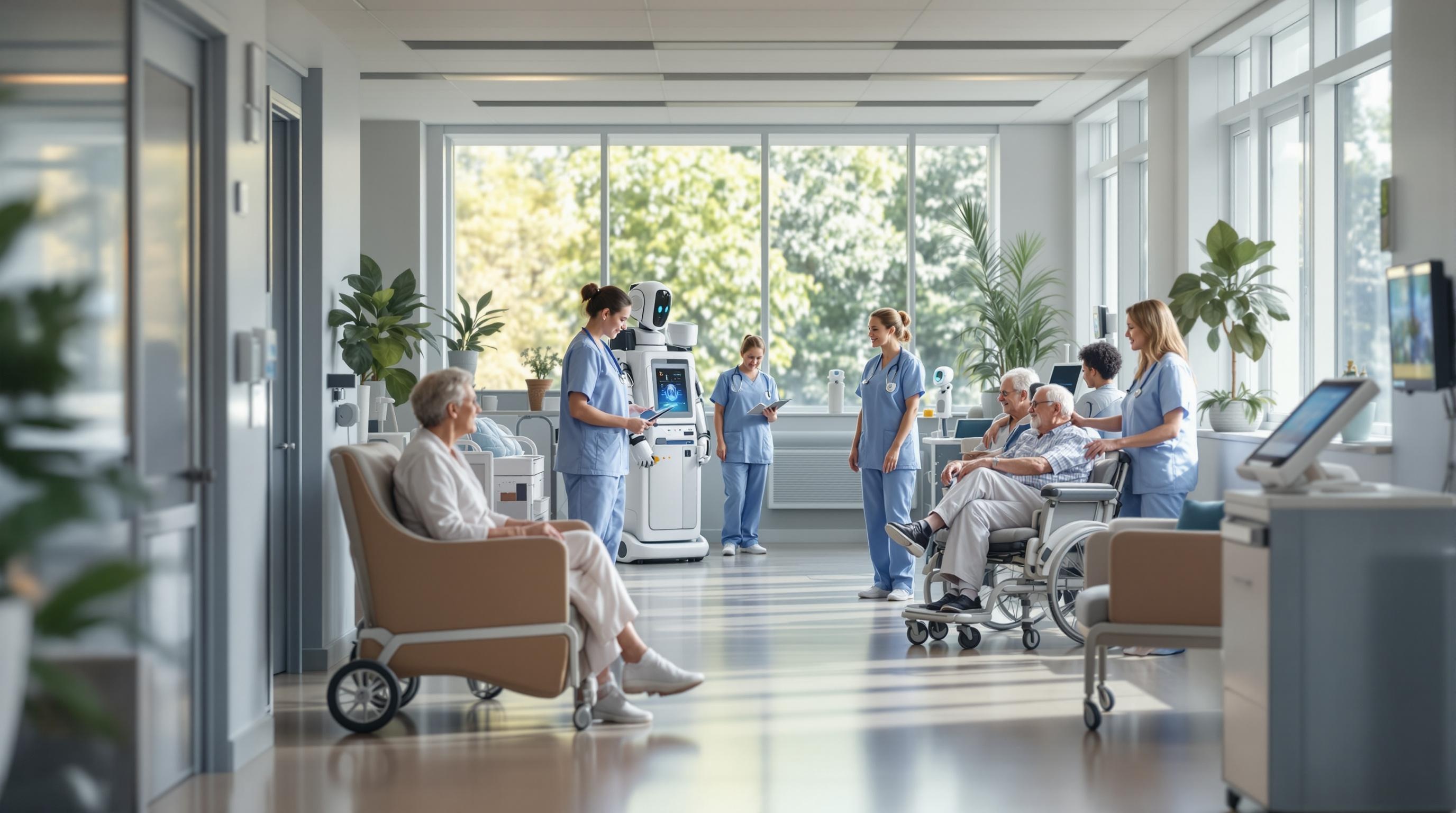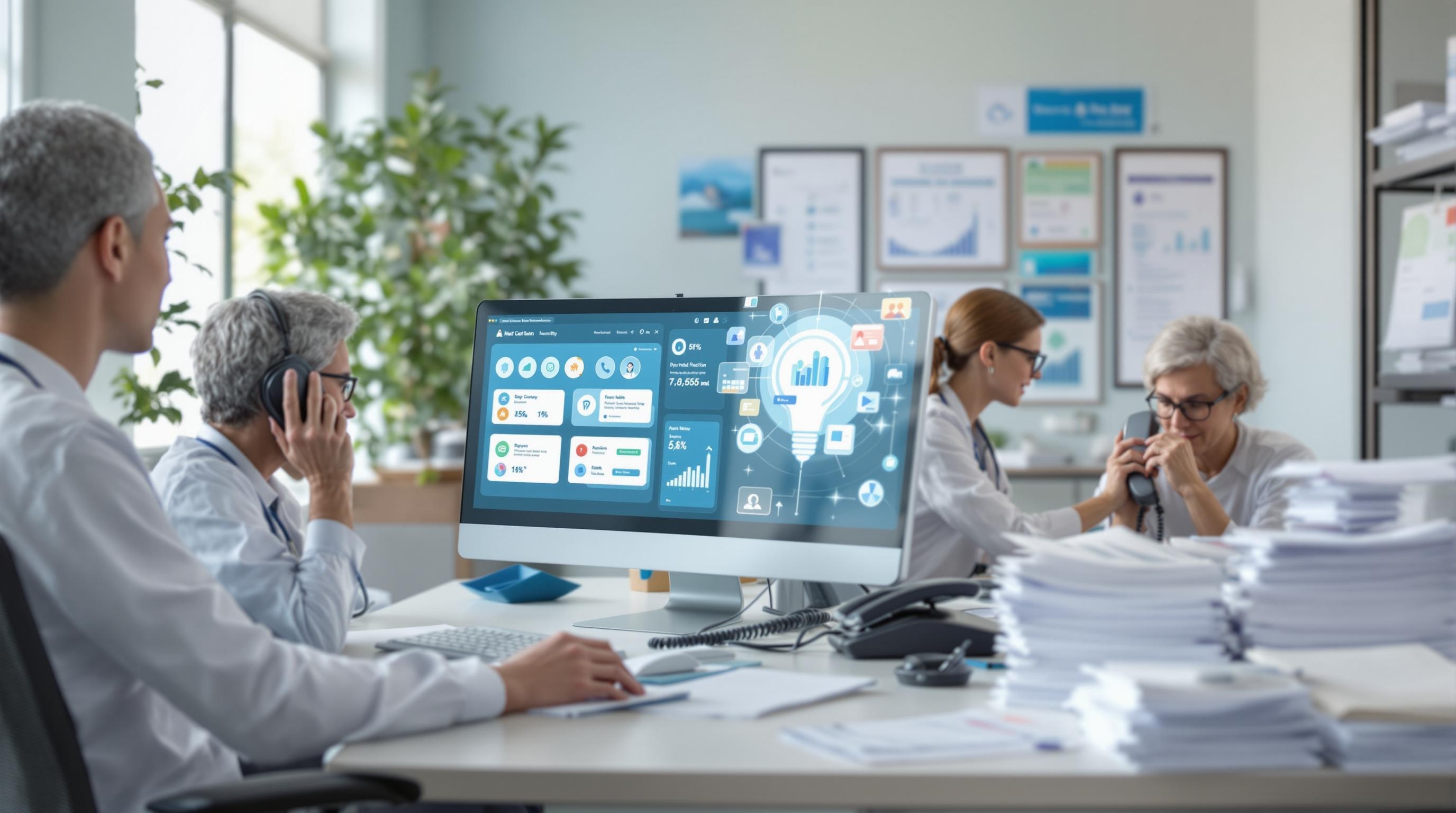Healthcare Automation vs Manual: Impact on Skilled Nursing Facilities
Discover how healthcare automation compares to manual processes in skilled nursing facilities. Learn the benefits, challenges, and future trends.
Quick Navigation
- 1. Introduction
- 2. Current Challenges in Healthcare Automation Vs Manual
- 3. How Sparkco AI Transforms Healthcare Automation
- 4. Measurable Benefits and ROI
- 5. Implementation Best Practices
- 6. Real-World Examples
- 7. The Future of Healthcare Automation Vs Manual
- 8. Conclusion & Call to Action
1. Introduction
Did you know that nearly 240,000 nursing home employees—about 15% of the workforce—have left the industry since the start of the COVID-19 pandemic? (Source). Staffing shortages have become a defining challenge for skilled nursing facilities across the nation, impacting everything from resident care to regulatory compliance. As operators struggle to maintain quality and manage rising operational costs, the question of how best to streamline daily workflows has never been more urgent.
Enter automation: a wave of healthcare technology that promises to relieve overburdened staff, reduce administrative errors, and give teams more time to focus on residents. But with every promise comes a debate—how does healthcare automation really stack up against traditional, manual processes? Are automated solutions the answer to chronic staffing shortages, or do they introduce new complexities that skilled nursing leaders must navigate?
In this article, we’ll dive into the realities of healthcare automation versus manual processes in skilled nursing facilities. We’ll examine how automation is addressing staffing gaps, discuss the challenges and limitations of both approaches, and explore which tasks benefit most from technology. Whether you’re a facility administrator, nurse, or industry stakeholder, understanding the balance between innovation and hands-on care is crucial for success in today’s evolving skilled nursing landscape.
2. Current Challenges in Healthcare Automation Vs Manual
Healthcare facilities today face a complex landscape as they balance the adoption of automation technologies with established manual processes. While automation promises improved efficiency and accuracy, its integration is far from seamless. Facilities must address a range of pain points that can impact operations, regulatory compliance, and—most importantly—patient care.
- Complex Integration with Legacy Systems: Many healthcare organizations still rely on outdated manual or semi-automated systems. Integrating new automation solutions with these legacy platforms can lead to data silos, workflow disruptions, or even errors if not managed carefully. According to a Signity Solutions report, up to 60% of healthcare providers face significant integration challenges when deploying new digital tools.
- High Initial Costs and Resource Allocation: Implementing automation requires large upfront investments in software, hardware, and staff training. For skilled nursing facilities and smaller healthcare providers, these costs can be prohibitive. The Journal of Computers in Human Services highlights that budget constraints remain a top barrier, with 45% of surveyed administrators citing cost as the leading obstacle to automation adoption.
- Data Security and Compliance Risks: Automation increases the volume and complexity of patient data being processed. Ensuring HIPAA compliance and guarding against breaches is more challenging as automation systems interact with multiple databases and external vendors. A recent study reported that 34% of healthcare facilities experienced compliance issues directly linked to new automation deployments.
- Staff Resistance and Adaptation Issues: Transitioning from manual to automated workflows can meet resistance from healthcare staff, who may be concerned about job security or overwhelmed by learning new technologies. According to Signity Solutions, nearly 40% of facilities cite staff adaptation as a significant hurdle in automation projects.
- Limited Customization and Workflow Mismatch: Off-the-shelf automation tools may not align perfectly with a facility’s unique manual processes. This can result in workflow bottlenecks, forcing staff to use workarounds that diminish the intended efficiency gains. Only 27% of healthcare organizations report that their automation tools fully meet their operational needs (source).
- Impact on Patient Care Continuity: Over-reliance on automation without robust oversight can lead to errors in patient records, delayed responses, or missed care opportunities—especially during system outages or data migration phases. Manual checks and balances remain critical, but maintaining this dual approach increases operational complexity.
- Scalability and Long-term Maintenance: As regulations and healthcare needs evolve, automated systems require regular updates and maintenance. Facilities with limited IT resources struggle to keep up, risking outdated or vulnerable systems that compromise both compliance and care quality.
The intersection of healthcare automation and manual processes presents significant operational, compliance, and patient care challenges. While automation offers transformative potential, healthcare facilities must navigate integration hurdles, financial barriers, and ongoing staff training to fully realize its benefits. For more information on the challenges and solutions related to healthcare automation, visit Signity Solutions and Computers in Human Services.
3. How Sparkco AI Transforms Healthcare Automation
Healthcare organizations, especially skilled nursing facilities, face mounting challenges as manual processes struggle to keep pace with rising patient volumes, complex compliance demands, and ongoing staffing shortages. Sparkco AI addresses these critical issues by replacing time-consuming, error-prone manual workflows with intelligent automation—empowering healthcare teams to deliver higher quality care with greater efficiency.
Key Features and Capabilities of Sparkco AI
- Automated Documentation: Sparkco AI streamlines clinical and administrative documentation by capturing, organizing, and populating patient data automatically. This eliminates repetitive manual entry, reduces human error, and ensures that records are always current and complete.
- Smart Scheduling and Staffing: Leveraging predictive analytics, Sparkco AI optimizes staff schedules based on real-time patient needs and historical trends. This minimizes understaffing and overstaffing, directly addressing the staffing shortages that have intensified post-pandemic.
- Compliance Automation: The platform automates compliance checks and reporting, ensuring adherence to HIPAA and other regulatory standards. By flagging incomplete data and generating required documentation, Sparkco AI helps organizations avoid costly penalties and audits.
- Error Reduction and Data Accuracy: Automated workflows significantly reduce manual mistakes, such as missed documentation or data inconsistencies. Sparkco AI cross-references multiple data sources in real time, ensuring accuracy and reliability for both care teams and administrators.
- Seamless Integration: Designed with interoperability in mind, Sparkco AI integrates effortlessly with existing Electronic Health Records (EHRs), billing systems, and other healthcare software. This unified approach eliminates workflow silos and maximizes the value of current technology investments.
- Real-Time Insights and Alerts: By continuously analyzing operational and clinical data, Sparkco AI delivers actionable insights and timely alerts. This enables proactive decision-making, early intervention, and improved patient outcomes.
Solving Manual vs Automated Healthcare Challenges
Manual processes in healthcare are notorious for being slow, error-prone, and resource-intensive. Staff often spend hours on paperwork, data reconciliation, and compliance reporting—time that could be better spent on direct patient care. Sparkco AI directly addresses these pain points:
- Boosts Efficiency: Automated workflows free staff from repetitive administrative tasks, allowing them to focus on high-value clinical work.
- Reduces Costs: By minimizing manual errors and streamlining operations, Sparkco AI helps facilities cut unnecessary expenses and improve resource allocation.
- Enhances Patient Care: With accurate, up-to-date information always available, clinicians can make better decisions and respond quickly to patient needs.
- Improves Morale and Retention: Automation reduces burnout by easing the paperwork burden, making it easier to recruit and retain skilled staff.
Technical Advantages & Integration
Sparkco AI is designed for rapid, low-disruption integration with existing healthcare systems. Its cloud-based architecture ensures secure, HIPAA-compliant data handling, while its intuitive interface requires minimal training. Whether a facility is looking to automate a single process or transform its entire workflow, Sparkco AI adapts to the organization's needs—bridging the gap between manual inefficiency and the future of automated healthcare.
4. Measurable Benefits and ROI
Automating key workflows in healthcare facilities, including skilled nursing and long-term care, generates measurable returns on investment (ROI) that far surpass manual processes. According to Boston Software Systems, three out of four hospitals list efficiency as a top financial concern, yet many have yet to fully realize the transformative impact of automation. Below, we outline the most compelling, data-driven benefits of automation over manual healthcare operations.
-
1. Time Savings: Up to 70% Faster Processes
Automated workflows—such as patient admissions, billing, and data entry—reduce process times by up to 70%. For example, automating prior authorizations can cut approval times from several days to just a few hours, streamlining patient care and reducing administrative workloads (Boston Software Systems). -
2. Cost Reduction: Average 30% Lower Administrative Costs
The Healthcare Financial Management Association (HFMA) reports that automating revenue cycle management can lower administrative costs by 30% or more. For a mid-sized facility, this translates to hundreds of thousands of dollars in annual savings (HFMA). -
3. Error Reduction: 85% Fewer Manual Entry Mistakes
Manual data entry is a leading cause of medical errors. Automation reduces these errors by up to 85%, minimizing costly claim denials and improving patient safety (RevCycle Intelligence). -
4. Enhanced Compliance: 25% Fewer Audit Findings
Automated documentation and reporting help ensure facilities meet regulatory compliance standards, resulting in up to 25% fewer audit findings and penalties (Boston Software Systems). -
5. Improved Cash Flow: 50% Faster Claims Processing
Automation accelerates the claims lifecycle, reducing time to payment by 50%. Providers receive reimbursements faster, improving cash flow and financial stability (HFMA). -
6. Staff Productivity: Up to 40% Reallocation to Patient Care
By automating repetitive tasks, skilled nursing facilities can redirect up to 40% of administrative staff time to direct patient care and quality improvement initiatives (Boston Software Systems). -
7. Patient Satisfaction: 20% Higher Scores
Faster admissions, fewer billing errors, and more attentive staff drive patient satisfaction scores 20% higher in automated facilities compared to those relying on manual processes (Becker's Hospital Review). -
8. Scalability: 100% Readiness for Volume Surges
Automated systems easily scale to accommodate spikes in patient volume, with no proportional increase in staffing or risk of errors—a critical advantage during public health emergencies.
Ultimately, healthcare automation drives substantial ROI through time and cost savings, enhanced compliance, and improved care quality. For more insights and real-world case studies, visit Boston Software Systems and HFMA.
5. Implementation Best Practices
Successfully transitioning from manual to automated healthcare processes requires a structured, thoughtful approach. Automation can improve compliance, data security, and operational efficiency—but only if implemented correctly. Here are actionable steps for a smooth and effective implementation, with practical tips and common pitfalls to avoid.
-
Assess Current Workflows
Begin by mapping out existing manual processes. Identify repetitive tasks, bottlenecks, and compliance risks.
- Tip: Interview staff at all levels for a comprehensive picture.
- Pitfall: Overlooking informal “workarounds” that may not be documented.
-
Define Clear Objectives
Set specific goals for automation, such as reducing errors, improving HIPAA compliance, or accelerating data retrieval.
- Tip: Align objectives with regulatory requirements and organizational priorities.
- Pitfall: Vague goals make it hard to measure success.
-
Select the Right Tools and Partners
Choose automation solutions that integrate seamlessly with your existing systems and are designed for healthcare compliance.
- Tip: Vet vendors for HIPAA and security certifications.
- Pitfall: Focusing solely on cost rather than long-term compliance and interoperability.
-
Plan Data Migration Carefully
Ensure accurate and secure transfer of existing data into new automated systems.
- Tip: Test data migration with a pilot group before full rollout.
- Pitfall: Data mismatches or loss due to poor planning.
-
Engage and Train Staff Early
Involve frontline employees in the transition and provide thorough training on new tools and protocols.
- Tip: Use super users or champions to support broader adoption.
- Pitfall: Neglecting change management and staff buy-in, leading to resistance.
-
Monitor Compliance and Performance
Establish clear KPIs and regular audits to ensure automated processes meet compliance standards and deliver expected benefits.
- Tip: Use dashboards for real-time monitoring.










